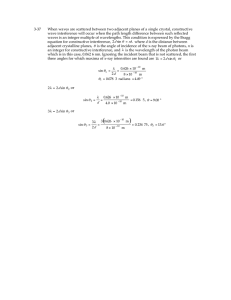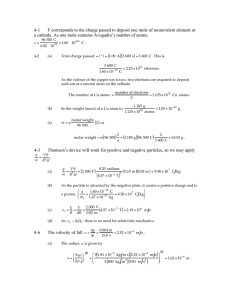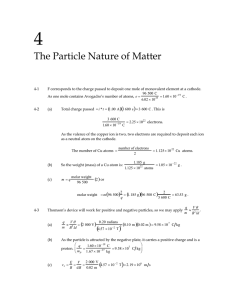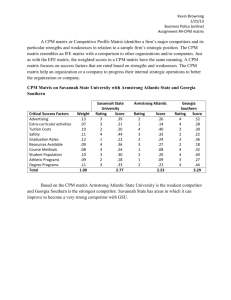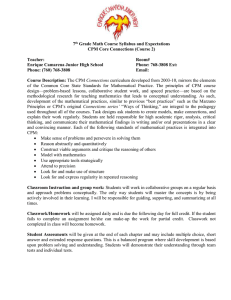Document 10908558
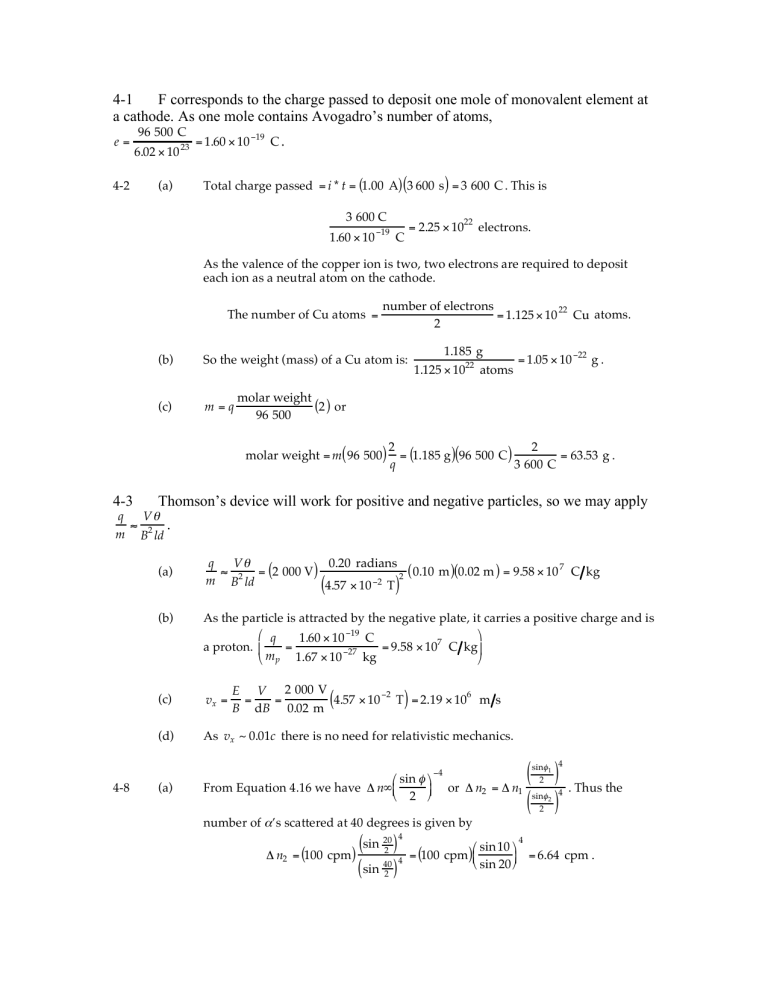
!
!
!
!
!
!
!
4-1 F corresponds to the charge passed to deposit one mole of monovalent element at a cathode. As one mole contains Avogadro’s number of atoms,
96 500 C e =
6.02
" 10
23
= 1.60
" 10 # 19
C .
4-2 (a) Total charge passed = i * t = ( 1.00 A ) ( 3 600 s )
= 3 600 C . This is
3 600 C
= 2.25
" 10
22
electrons.
1.60
" 10 # 19
C
As the valence of the copper ion is two, two electrons are required to deposit each ion as a neutral atom on the cathode. number of electrons
The number of Cu atoms =
2
= 1.125
" 10
22
Cu atoms.
(b) So the weight (mass) of a Cu atom is:
1.185 g
1.125
" 10
22
atoms
= 1.05
" 10 # 22
g . molar weight
(c) m = q
96 500
( ) or molar weight = m ( 96 500 )
2 q
=
( 1.185 g ) ( 96 500 C )
2
3 600 C
= 63.53 g .
4-3 Thomson’s device will work for positive and negative particles, so we may apply q V #
"
. m B
2 ld
(a)
(b) q m
"
V #
B
2 ld
=
( 2 000 V )
(
0.20 radians
4.57
$ 10 % 2 T
2
)
( 0.10 m ) ( 0.02 m ) = 9.58
$ 10
7
C kg
As the particle is attracted by the negative plate, it carries a positive charge and is a proton.
$ q
&
% m p
=
1.60
" 10
# 19
1.67
" 10 # 27
C
kg
= 9.58
" 10
7
C kg
'
)
(
(c)
(d) v x
=
As v x
E
B
V
= d B
=
2 000 V
0.02 m
( 4.57
" 10 # 2
T )
= 2.19
" 10
6
m s
~ 0.01
c there is no need for relativistic mechanics.
4-8 (a) From Equation 4.16 we have " n #
% sin
& 2
$ (
)
+ 4
or " number of α ’s scattered at 40 degrees is given by n
2
" n
2
=
( 100 cpm )
( sin 20
2
) 4
4
( sin
40
2
)
= " n
1
=
( 100 cpm )
# sin10
$ sin 20
&
'
4
( ) 4
( ) 4
. Thus the
= 6.64 cpm .
!
!
!
!
!
!
!
!
!
!
!
!
!
!
!
Similarly
" n at 60 degrees = 1.45 cpm
" n at 80 degrees = 0.533 cpm
" n at 100 degrees = 0.264 cpm
(b) From 4.16 doubling
" 1
# 2
%
& m
( v
2
(
reduces " n by a factor of 4. Thus " n at
20 degrees =
" 1
# 4
%
&
( 100 cpm )
= 25 cpm .
(c) From 4.16 we find
" n
" n
Cu
Au
=
Z
Z
2
Cu
2
Au
N
Cu
N
Au
, Z
Cu
= 29 , Z
Au
= 79 .
N
Cu
= number of Cu nuclei per unit area
= number of Cu nuclei per unit volume * foil thickness
=
)
+
*
( 8.9 g cm
3 )
# 6.02
" 10
23
%
$
nuclei
63.54 g
& ,
(
'
.
t = 8.43
" 10
-
22 t
N
Au
=
)
+
*
( 19.3 g cm 3 )
# 6.02
" 10
$
23
nuclei
197.0 g
& ,
.
t = 5.90
" 10
'
-
22 t
So " n
Cu
= " n
Au
( )
2
8.43
# 10
( )
2
22
( 5.90
# 10
2 )
= ( 100 )
$ 29
% 79
'
(
2
$ 8.43
% 5.90
'
(
=
19.3 cpm .
4-9 The initial energy of the system of α plus copper nucleus is 13.9 MeV and is just the kinetic energy of the α when the α is far from the nucleus. The final energy of the system may be evaluated at the point of closest approach when the kinetic energy is zero and the potential energy is
Ze r
where r is approximately equal to the nuclear radius
!
of copper. Invoking conservation of energy r = ( ) k
2 Ze
K
"
( )
2
=
(
( ) 29 ( 1.60
13.9
# 10
6
#
eV )
E i
(
10
= E
$ 19
1.60
f
#
)
2
,
K
"
( 8.99
# 10
9
10 $ 19
= k
2 Ze
2
J eV
)
) r
or
= 6.00
# 10
$ 15
m
.
!
!
!
!
!
!
